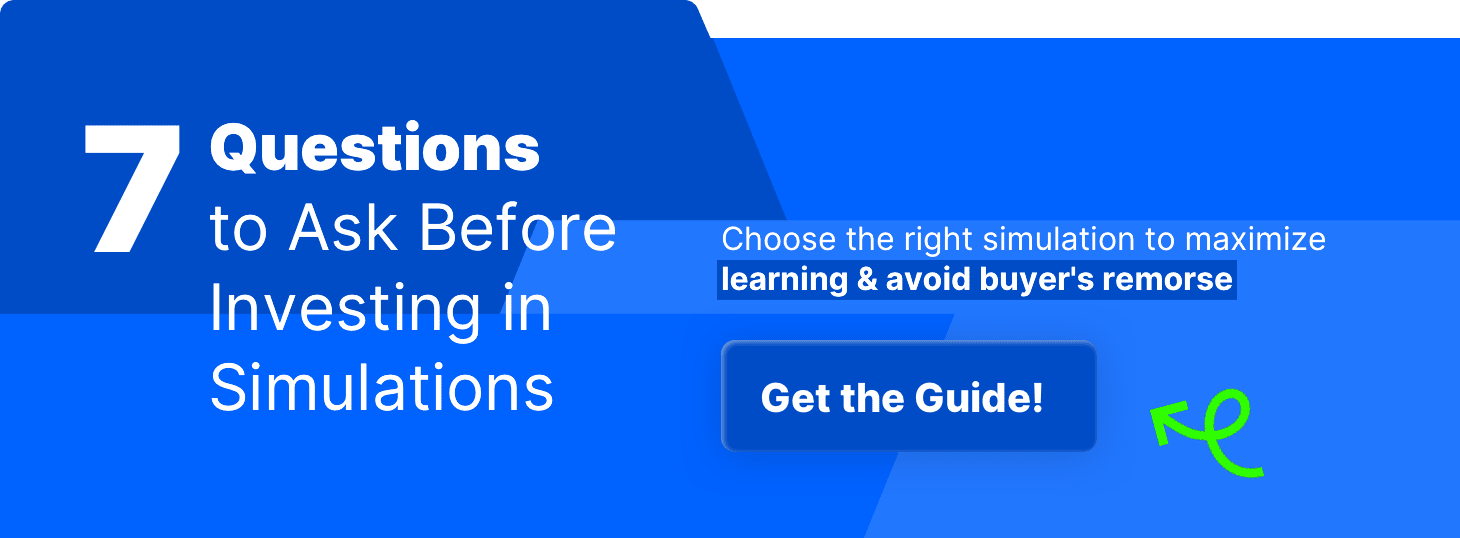7 Reasons to Make Simulation Training a Part of Your L&D Program
October 27, 2021

Just how important is your learning and development department? Consider this.
First, we know several trends are all happening at once, spurred on by technological innovation and the Covid-19 pandemic:
- Automation and artificial intelligence are taking over roles and decision-making processes that once belonged to humans.
- A multigenerational workforce is learning how to work well together despite their differences.
- Hard skills and knowledge have a shorter shelf-life, making upskilling and reskilling a high-value “to-do” on every L&D leader’s list.
On top of that, research has found that learning and development plays a crucial role in a company’s bottom line.
- 77 percent of employee turnover could’ve been prevented by employers.
- 93 percent of employees will stay at a job longer if their employer invests in career development.
- Companies that spend at least $1,500 per employee annually report 24 percent more profit.
The point is clear: learning and development departments play a huge role in their companies' success and continued growth. They must make the most of their resources and develop employees that drive their company forward.
The companies that will win in this decade will maximize the potential of their talent and keep them in the company for the long haul.
How? Simulation training is a key component that must be a part of every L&D program. In this article, we’ll cover exactly what simulation training is, how it can benefit your L&D program, and the specific L&D challenges it helps solve.
Start with the Basics: What is Simulation Training?
Simulation training is situational learning delivered in a format that puts the learner into a real-world scenario to execute specific tasks. It’s a way for learners to apply the knowledge gained from lectures into practice.
This knowledge application component is what makes simulations a vital part of any L&D program. German psychologist Hermann Ebbinghaus found that humans forget about 75 percent of knowledge learned after six days unless applied. Another study from 2011 found that less than 20 percent of knowledge acquired can be skillfully applied.
Simulation training is a safe practice environment where concepts meet realistic scenarios to help learners make vital connections and improve their job performance.
Types of Simulation Training Available to L&D Departments
There are several types of simulation training available for use today. Here’s a brief overview of some of the most common types of simulations:
Video-Based Simulations
Video-based simulations use videos to recreate a work scenario and place the learner “in” the situation. Top-shelf video simulations deliver an incredibly immersive experience, combining audio and visuals to enhance the life-like nature of the programs. They are similar to role-playing video games where the decisions you make as your “character” result in various consequences for the learner.
You can either purchase a library of video simulations on various topics or go the custom-build route. Each has its pros and cons.
If you invest in the library solution, you get a lot of video simulations in one purchase and can get up and running fairly quickly. But the programs may not be 100 percent relevant to your employees.
If you go the custom route, you’ll be able to design simulations tailored to specific roles and skills. But you may have to wait a bit and pay a premium for the work.
Virtual Reality or Augmented Reality Simulations
VR and AR are hot topics in just about every industry right now. They give consumers and businesses the ability to see how a product or service will work for them in a near-real-life environment. This is especially true in training simulations using VR/AR.
These types of simulations are massively engaging and immersive, and have been shown to decrease time to training completion, increase learner confidence, and provide more emotionally engaging training.
But just like video-based simulations, you have the same tradeoffs: waiting time and cost. Some VR solutions can break the corporate bank account. VR/AR simulations can take months to code and build out, and you can easily spend thousands on just one or two simulations.
Inbox Simulations
Inbox simulations mirror the look and feel of a business inbox and company-wide instant messaging to simulate a day in the life of a particular role. While they lack the high-impact visuals of video-based simulations or VR/AR, inbox simulations provide a full day’s worth of decision-making in 30 minutes or less.
You also don’t have to choose between getting started quickly and sacrificing relevance to your employees. Inbox simulations, such as CapsimInbox, allow you to either purchase proven, pre-built simulations, build your own via an authoring platform, or go with a custom build.
Business Simulations
Business simulations focus on strategic cross-functional decision-making while trying to run a fictional business. They are a great instructional tool for training executive, director, and managerial roles. While they don’t require a long wait time for development, they require multiple days to implement and run through.
While these are the options available to L&D leaders, the real question is, do they work?
Can Simulation Training Help Solve These 7 Common L&D Challenges?
With L&D playing a more crucial role than ever in a company's success, corporations need to overcome key challenges. Looking at several surveys across learning and development, these are just some of the obstacles L&D leaders and their teams have to conquer in 2021 and beyond.
- Reacting quickly to industry or company changes. This was never more apparent than in 2020, but the pandemic is not the only change of which L&D teams must be mindful. Shifting workplace models, technological advancements, and a greater emphasis on soft skills vs. technical skills are three examples of changes L&D leaders currently face.
- Providing development opportunities in a remote work model. How do you provide relevant training opportunities to employees who aren’t all together in an office? L&D teams must find web-based development solutions that are both engaging and effective.
- Upskilling and reskilling. Competition is high for workers with in-demand skills, so L&D leaders must find a way to grow and develop in-house talent through upskilling and reskilling initiatives.
- Improving critical soft skills. With more parity in technical skills, access to technology, and access to online learning for technical skills, the companies who win this decade will do so by delivering a top-shelf customer experience fueled by soft skill excellence.
- Improving learner engagement and satisfaction. These metrics point to training that is working and makes employees feel valued enough to receive effective, relevant development opportunities. Improving both metrics lifts L&D’s status and helps build toward a culture of continuous learning.
- Fitting effective development into the workday. If training sessions are too long, employees resent them because it puts them behind on their work. However, some shorter training options, such as video-based content, may not be relevant to them. Training has to both fit into the workday and apply to their day-to-day work.
- Creating a culture of infinite learning. On top of everything above, L&D teams must align every initiative, platform, and tool to engrain continuous improvement and development into their company’s DNA.
Can simulation training help solve these common learning and development challenges? The answer is “yes.” Here’s why.
1. New Simulations can be Created Quickly
Challenge it solves: Reacting quickly to industry or company changes.
Changes happen, whether it’s a company going remote overnight or a change in company strategy requiring immediate hiring and reskilling. The faster you react, the sooner you can turn the ship that is your company to sail with the new tides.
Instead of waiting months to start reskilling employees, you can begin as quickly as a week or two from signing on the dotted line. That time is invaluable to getting employees trained up and producing.
Not all simulations offer this capability. Custom-made video and VR/AR simulations are out because it takes time to develop a solution. Off-the-shelf video simulations, VR/AR simulations, and inbox simulations can be delivered quickly as the content is pre-made and ready for use.
However, with these “off the shelf” solutions we return to the issue of sacrificing quality and pertinence for the sake of speed. With a tool like CapsimInbox’s Authoring Platform, L&D teams can quickly create customized inbox simulations tailored to minimize specific employee skill gaps.
Inbox simulations can also be valuable assessment tools for intense hiring booms. L&D and HR can come together to create short simulations focused on measuring critical soft skills to whittle down the interview list and prevent time-wasting interviews for candidates who aren’t good fits.
2. Simulations are Delivered "As a Service"
Challenge it solves: Providing development opportunities in a remote work model.
A remote workforce introduces a few additional obstacles for L&D teams:
- Accompanying materials must either be shipped or sent to employees for them to print on their own.
- Employees spread across various locations limits access to certain training tools and techniques.
- It becomes more challenging to get employees into real-world role-play situations.
The web-based, “as a service” nature of certain types of simulations means your employees have access to engaging and applicable development regardless of where they work. All that’s required is an internet-connected computer and a login to the platform.
3. They're Based on Real-World Situations
Challenge it solves: Upskilling and reskilling
When it comes to upskilling and reskilling employees, they need repetitions. Like a golfer learning to hit a draw instead of a fade, your employees need to practice repeatedly to ingrain their new skills and develop the required soft skills.
This requires our chosen type of simulation to hit a few key criteria:
- The simulation must be customized to the new role or skills they need.
- The simulation must reinforce the required soft skills.
- The simulation must be based on real-life situations for a given role.
For example, let’s say a member of your marketing team has been promoted to director of marketing. As an L&D professional, you want to give them the necessary tools for success in their new role. Therefore, their development plan should center on the activities, decisions, and skills a director of marketing would rely on daily, such as:
- Creating a marketing plan
- Advocating for more budget
- Managing team members and personnel issues
- Critical thinking when faced with obstacles
- Other day-in-the-life situations a director of marketing would face
The bottom line is that simulations are a crucial component of upskilling and reskilling because they put employees in real-world situations without the associated risks. Simulation training also helps employees think critically and solve problems they may face in their new roles.
4. Simulations Keep Learners Engaged
Challenge it solves: Learner engagement and satisfaction
How do simulations increase learner engagement and satisfaction? Stories, progress tracking, and feedback loops.
Storytelling engages specific sensory points of the brain. Neuroscientists at Princeton University studied the power of stories and found that certain parts of the brain in both the storyteller and the listener lit up with activity. Why? Because when we hear a well-told story, our brains try to place us in the story.
That’s how simulations engage your learners. At their core, simulations are story-based learning modules that put learners in contact with other “characters.” Simulation training immerses learners in real-life scenarios relevant to their role and their work.
Compare this to multi-hour classroom sessions with PowerPoints. It’s incredibly hard to keep employees engaged for longer than 30-40 minutes. With simulations, you keep employees engaged with short (30 minutes or less) game-like training modules.
Additionally, learners get immediate, actionable feedback. Instead of simple right/wrong quizzes that only test knowledge retention, simulation training platforms keep comprehensive statistics on progress in target skill areas.
Progress measurement is also key to engagement and satisfaction. Going back to our golf example, it’s like a player tracking their scores throughout the summer to see how much better they get. They’re trying to go from 100 strokes per round to 85 strokes per round. They have two principles that are key to measuring their progress:
- A target (85 strokes per round)
- A channel for immediate feedback (their scorecard for each round)
The target presents a challenge to keep them engaged in getting better at golf. So they go to the practice range and do drills to get better at driving, chipping, and putting. Then when they go to the course, they use the techniques from their training.
At the end of the round (and even during it), they know their score and can see immediately if they’ve made progress.
Simulations offer the same story-based interface, progress measurement, and feedback loops.
5. Simulations can Help Address Soft Skill Gaps and Development Needs
Challenge it solves: Improving critical soft skills
We’ve written extensively about the power and necessity of soft skills in the modern workplace. In short, soft skills can be an advantage in an extremely competitive business climate.
But they are notoriously hard to train and teach. This is particularly true in hybrid and remote workforces. So how can you use simulation training to address this crucial need?
First, look for simulation platforms that include functionality for setting soft skill baselines and self-assessments. This capability helps point out soft skill gaps and provide self-awareness to your employees about where they stand.
Second, simulations provide the repetitions needed to develop soft skills. The immersive experience, focus on real-world situations for a particular role, and customization capabilities force employees to make decisions a person in a given role would face. This helps them practice for similar situations and develop critical thinking to solve problems in real-time.
6. Simulations Fit into Time Constraints without Losing Effectiveness
Challenge it solves: Fitting effective development into the workday.
How do you deliver super effective development opportunities employees love without taking up too much of their time? One word: microsimulations.
In addition to the benefits we’ve already covered, microsimulations deliver a maximum educational punch in 15-30 minutes. They eliminate the need for constant hour-long lectures or losing half a day to travel to a different training environment and back. Plus, actionable feedback is delivered immediately.
A practical example of a microsimulation is an inbox simulation using CapsimInbox. In less than 30 minutes, employees can go through the day’s worth of decisions and communication testing role-based skills and soft skills. Plus, your employees get instant performance feedback when they complete their simulation.
7. Simulation Training Helps Make Development Exciting and Fun
Challenge it solves: Building a culture of continuous development
“Training” and “career development” can carry negative connotations. Employees may be scarred from unengaging PowerPoint presentations or irrelevant speakers to a lack of a formal program at all. While we aren’t saying that simulation training alone is your missing link for building a culture of continuous development, it can help in a number of ways.
- The gamified, real-world experience is more interactive than classroom sessions or webinars. You can use simulations to break up knowledge-based instructional methods with a chance for employees to apply what they’ve learned.
- Specificity is key for enjoyment. If employees don’t feel like development opportunities are tailored to them, they don’t feel as effective or worthwhile. When they feel like training is worth it, they look forward to it.
- Making progress and getting better is fun! When you improve at something you care about, you get more enjoyment out of it. Because certain simulation training platforms track performance over time, your employees can celebrate progress and small wins, particularly when those translate into real-life results they may not have been able to achieve before.
- Performance tracking helps you create individualized plans. Imagine being able to offer custom-tailored learning and development as a job perk. Using a simulation training platform that tracks progress also helps you create individual development plans for your employees. If everyone is on a plan to get better, continuous improvement and learning become part of your company.
Simulation training breaks the mold and isn’t just “training” as people usually think of it. Again, we aren’t saying adding simulations to your L&D toolbox will achieve your goals overnight. You need to have the right simulation training platform that gives you flexibility and scalability to meet your exact needs to realize its full potential.
Take the Next Step: Level-Up Your L&D Program with Simulation Training
While there are many high-quality simulation solutions available to L&D departments, we only know of one that ticks all the boxes and meets vital criteria as an effective development tool: CapsimInbox.
But of all the things CapsimInbox is, the most important is its status as a validated, research-backed tool for achieving learning outcomes. From developing critical thinking skills in market analysts to developing financial acumen and soft skills, CapsimInbox has a near-infinite number of use cases.
But we understand you may not want to invest in simulation training just yet. That’s why we’ve created a resource to help you evaluate all your options: 7 Questions to Ask Before Investing in Simulations.
It will ensure you’re asking the right questions and looking for specific functionality to help you make the best decision.





.png?width=80&name=1-questions%20(1).png)